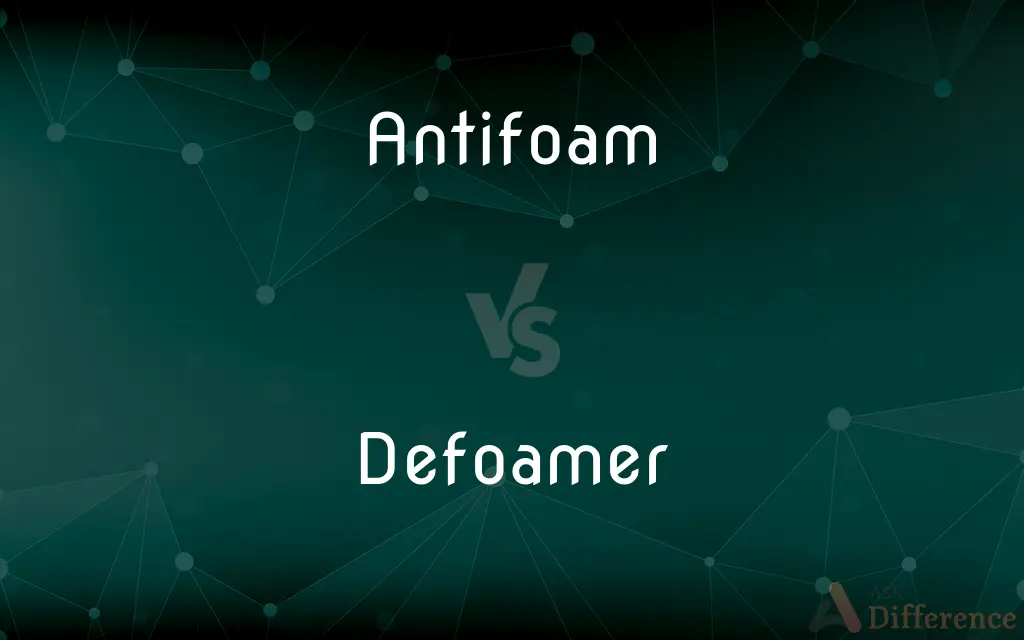Antifoam vs. Defoamer — What's the Difference?
By Tayyaba Rehman — Updated on September 27, 2023
Antifoam prevents foam formation, while defoamer is used to collapse existing foam. Both are additives in industrial processes.

Difference Between Antifoam and Defoamer
Table of Contents
ADVERTISEMENT
Key Differences
Antifoam and Defoamer are terms often used interchangeably, but they possess distinctions based on their application. Antifoam is predominantly used to prevent the formation of foam, which is crucial in industrial processes where foam can hinder efficiency. It is generally added before the process begins to avoid any foam development, ensuring smooth operations. By doing this, antifoam aids in maintaining the integrity of the production process, preventing delays and disruptions caused by foam.
In contrast, Defoamer is a chemical additive that is used to eliminate already formed foam. It acts swiftly to collapse the foam, which is essential in processes where the presence of foam can cause defects in the final product or decrease the efficiency of the process. By targeting and eliminating existing foam, defoamers play a crucial role in rectifying disruptions in industrial processes, maintaining the quality of the output.
It is crucial to note that while Antifoam primarily focuses on preventing foam formation, Defoamer emphasizes the elimination of existing foam. However, due to their closely related functions, many products are formulated to serve as both antifoam and defoamer, providing a versatile solution to issues related to foam in various industrial applications.
In summary, Antifoam and Defoamer, though closely related, are distinguished by their function and point of application in industrial processes. Antifoam is proactive, preventing the formation of foam, while defoamer is reactive, collapsing existing foam. Their precise application is pivotal in industries to maintain process efficiency and product quality.
Comparison Chart
Function
Prevents foam formation
Collapses existing foam
ADVERTISEMENT
Application Point
Added before foam forms
Added after foam has formed
Purpose
Maintains process efficiency
Rectifies disruptions and maintains quality
Usage
Used proactively
Used reactively
Dual Function
Can be formulated to act as defoamer
Often has antifoaming properties
Compare with Definitions
Antifoam
It is an agent added to prevent the formation of foam.
To ensure smooth processing, they added antifoam to the mixture.
Defoamer
It is a chemical agent used to collapse existing foam.
To rectify the foam issue, a defoamer was promptly added to the solution.
Antifoam
It represents a chemical additive used proactively to inhibit foam creation.
Antifoam was incorporated to maintain the quality of the paint.
Defoamer
It represents a substance applied to remove already formed foam swiftly.
To restore process efficiency, a defoamer was introduced to the mixture.
Antifoam
It is a substance applied to reduce surface tension preventing foam buildup.
In pharmaceutical manufacturing, antifoam is essential to maintain purity.
Defoamer
This agent is used to counteract foam formation, enabling smoother operations.
They added a defoamer to the coolant to avoid any disruptions.
Antifoam
This agent is utilized to control and minimize foam production in liquids.
To prevent delays, antifoam was added at the beginning of the brewing process.
Defoamer
This is an additive employed to eliminate foam in various processes.
Defoamer is essential in wastewater treatment to ensure proper functioning.
Antifoam
This is a substance used to hinder the development of foam in industrial processes.
In the food industry, antifoam is crucial to avoid overflowing during boiling.
Defoamer
It is a compound utilized to break down foam and prevent its recurrence.
In papermaking, defoamer is crucial to maintain the quality of the paper produced.
Antifoam
Any chemical agent that inhibits the formation of foam.
Defoamer
A defoamer or an anti-foaming agent is a chemical additive that reduces and hinders the formation of foam in industrial process liquids. The terms anti-foam agent and defoamer are often used interchangeably.
Defoamer
Any chemical agent used for defoaming.
Common Curiosities
Can a substance be both Antifoam and Defoamer?
Yes, many products are formulated to act as both antifoam and defoamer.
When is Defoamer applied?
Defoamer is applied after foam has already formed, to collapse it.
What is Defoamer?
Defoamer is a chemical additive used to eliminate already formed foam in industrial processes.
What is Antifoam?
Antifoam is an agent designed to prevent the formation of foam in liquids during industrial processes.
Is Antifoam proactive or reactive?
Antifoam is proactive, as it prevents foam from forming in the first place.
Share Your Discovery

Previous Comparison
Anxiety vs. Suspense
Next Comparison
Passband vs. StopbandAuthor Spotlight
Written by
Tayyaba RehmanTayyaba Rehman is a distinguished writer, currently serving as a primary contributor to askdifference.com. As a researcher in semantics and etymology, Tayyaba's passion for the complexity of languages and their distinctions has found a perfect home on the platform. Tayyaba delves into the intricacies of language, distinguishing between commonly confused words and phrases, thereby providing clarity for readers worldwide.
















































